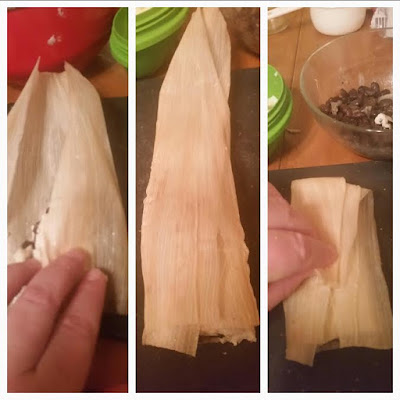About broth or stock: they're more or less the same thing, as the definitions seem to be changing over the years. I made the broth I used for this from kitchen scraps: stems from mustard greens and Swiss chard, a couple of leftover carrots, a stalk of celery, and half an onion left from some other recipe. If you don't want to make it, though, you can buy some pretty good canned or tetra-pack ones to keep in the cabinet. I like the organic chicken stock from Costco or the low-sodium (not reduced-sodium, which is still really salty) from TJs or Whole Foods.
Lentils and greens are one of my favorite earthy combinations, so I've put them together in a soup that can be made with or without a little bacon for added flavor. A humble but hearty soup with a little crusty bread on the side is just the thing for a delicious but inexpensive dinner. I don't usually measure anything for soup, but I did this time so I could share, and so I could make sure I didn't turn it into a stew by adding too much stuff!
All measurements can be adjusted, but start with:
-5 cups broth or water, or a mix of the two
-1/4 lb slab bacon (optional)
-2 tsp olive oil
-1 Tbsp red or white wine vinegar OR 1/4 c white wine
-1 onion
-2 carrots
-1 or 2 stalks of celery
-2 large cloves of garlic, or 3 small
-1 Tbsp tomato paste
-1 tsp cumin
-1/2 tsp turmeric
-1 c brown or green lentils, rinsed
-black pepper and salt to taste
-2-4 cups washed baby spinach leaves
If you want to use bacon but can't find slab bacon, just use some thick slices and cut them into 1/4 in wide strips.
If you have a slab, trim off the "rind" and save that for the next batch of broth you make. Cut the rest into 1/4 in (you know, 1/4 inch-ish) cubes.
Instant Pot: press the saute button and immediately add bacon and 1 tsp olive oil to pot. Saute until golden brown, stirring every couple of minutes.
Stovetop: put bacon and 1 tsp oil in a cold pan over medium heat. Saute until golden brown, stirring every couple of minutes. Remove bacon to a small bowl and set aside.
While the bacon cooks, finely dice the onions, carrots and celery. If you're a bell pepper kind of person, dice up one of those, too.
Saute those in the pan or pot you just cooked the bacon in. Add the vinegar or wine and scrape up the yummy brown stuff at the bottom of the pan, adding that flavor to the mix.
Add garlic, spices and tomato paste and saute about 5 minutes until everything is soft. Add a little black pepper and, if not using bacon, a little salt (1/2 to 1 teaspoon).
Add broth and water. Keep on saute in IP until liquid is warm or on medium in stock pot until liquid is at a simmer. Add lentils.
IP: Cancel saute and lock lid into place. Press manual and set for 8 minutes. Let machine do natural release for about 5 minutes, then do quick release. No need to unplug until after QR.
Stovetop: Put lid on pot, turn heat down to low and let simmer for an hour. Check periodically to make sure it's still at a simmer and bottom ingredients aren't sticking.
Add 2-4 cups baby spinach (or chopped big spinach with stems removed). Stir until wilted.
Stir in bacon if using.
Check for salt and pepper, adding more if needed. You may not need any more, depending on the ingredients you used (bacon and broth).
Serve up with whatever you need for an AH meal, or if not AH, crusty bread or your favorite crackers!









 a
a




































 p
p


